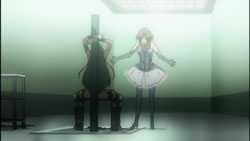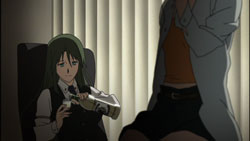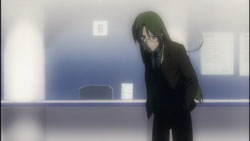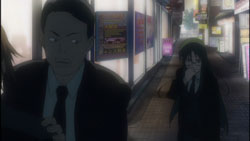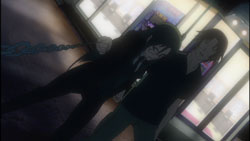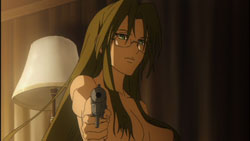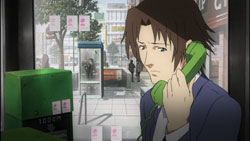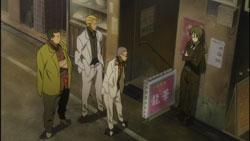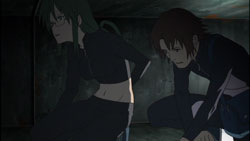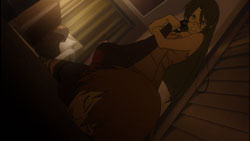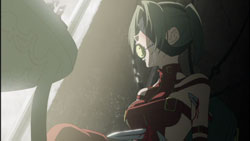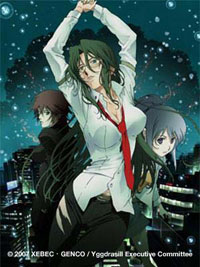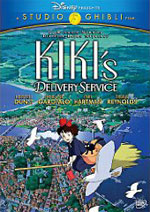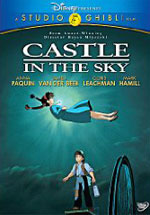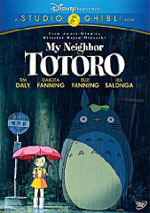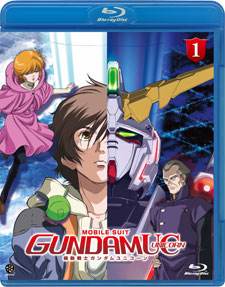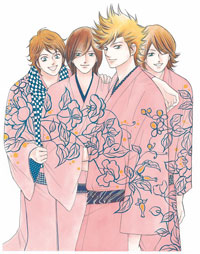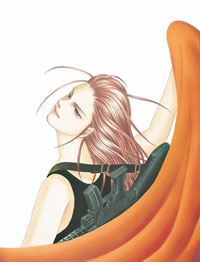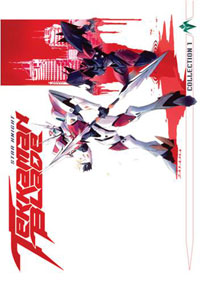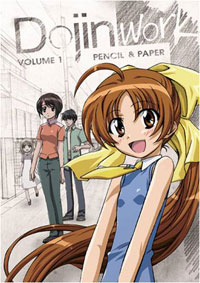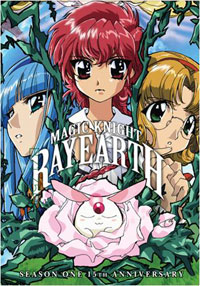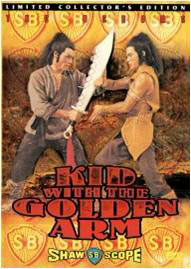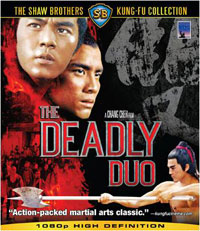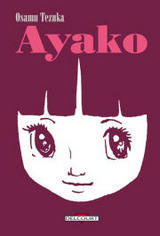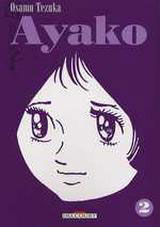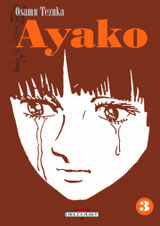 Logo handmade by Bannister
Column by Scott Green
Logo handmade by Bannister
Column by Scott Green
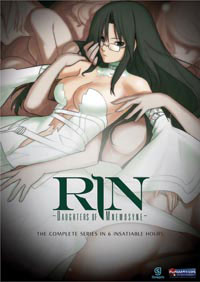
Anime Spotlight: Rin ~Daughters of Mnemosyne~ Released by FUNimation
Taking Halo Legends off the table for a moment... Unless Summer Wars (or hope beyond hope, Mind Game) get scheduled for North American release, if you buy one anime title this year, buy Rin ~Daughters of Mnemosyne~. Not because it's the absolute best work that's going to be released over the course of the year (I hope). Because, if you're buying one anime release in a calendar year, Rin ~Daughters of Mnemosyne~ is probably the kind of title that'll interest you. Long time blood and spectacle anime fans, this is it. Are you old enough to remember when anime was synonymous with violent porn and not moe body pillows? Konya wa Hurricane? "Gemma! Burn in your golden hell!"? When it was about seeing what freaky flick was sitting next to Super Deformed Double Feature on the Blockbuster shelf, regardless of whether you were also finagling VHS tapes from Japan? Anime hasn't really been in the business of fulfilling that niche in awhile. There was Strait Jacket kindof, though I wouldn't really recommend it. Karas, kindof, and I've grown to like that more in hindsight, though it’s not terribly transgressive. It wasn't conceived for that set of interests, but I consider Shigurui: Death Frenzy a suitable fit. Afro Samurai probably counts, but the anime was crossover material from the ground up. Now, we're getting Rin ~Daughters of Mnemosyne~, the best of this breed to be seen in North America in a while, with no clear rivals on the horizon. I wouldn't say that it is absolutely outstanding. Contrary to what I think the writer thought he was developing, it's wading pool deep. There's a lot more watching and seeing what will happen than there is active involvement. Yet, the notion of a light touch is alien to the production, and that turns out to be to its benefit. The gratuitous shower scene makes a triumphant return courtesy of a lead with an affinity for washing and putting on slinky gowns. The plot navigates towards sex scenes like a bee to a flower. It's got sex, and violence, and tons of sexualized violence such that its signature scene involves the lead being bound to a chair and tortured via piercing by a woman in a loligoth ensemble. From that bit of flagrant nastiness, it's on the table. This is going to be an anime that licks its lips at the thought of sadomasochistic violence. Fortunately, unlike a lot of anime in recent years, these objects of these gag and skewer spectacles are, for the most part, adult.As wrongheaded as bits of the premise of something like Wicked City might be, I've never been bothered by gratuitously trashy anime of the Yoshiaki Kawajiri variety. There is a threshold of blatancy after which I find it all fun rather than irksome. As such, even the anti-Semitism of Ichiro Itano's Angel Cop (scrubbed out of the localized version) was only worth a raised eyebrow. What bothers me is when anime tries to both moralize about and indulge in salaciousness. It spoils the fun when a work of anime starts wringing its hands or wrapping the audience's knuckles for enjoying the slick violence that it went through great pains to deliver. Anime does have great dark, tragic stories, but its tragedy porn has a tendency to be more odious that its torture porn. The latter is often too wrapped up in the presentation layer to get into too much trouble. Happily, Mnemosyne is unabashedly pulp. Episode titles like "Cat's Don't Laugh," "Angels Don't Cry" and "Flowers Don't Shed Tears" are sure to correct any remaining confusion as to whether or not this is dime novel business. Its creators have no problem doing what they're doing. The gratuitous and nasty bits don't quit have the natural flow of Kazuo Koike or mania of Go Nagai, but it works. Mnemosyne has an unconventional origin and format. It's six, 45 minute episodes. Normally, this would suggest that the anime was distributed direct to video - an Original Video Animation (OVA). Actually, Mnemosyne was broadcast as a tenth anniversary special on Anime Theater X (AT-X). This station runs a lot of Comic Gun works, like the girl fight adaptation of classic novel Romance of the Three Kingdoms - Ikkitousen; and it runs them uncut (for example, Charge Girl Juuden-chan was unedited on AT-X, but available in its sanitized version in North America via streaming site Crunchyroll). Airing there, Mnemosyne had the freedom to go a bit nuts with nudity, blood and wounds. I don't want to oversell Mnemosyne's brutality. I can think of plenty of manga with scenes that are more explicit and off-putting... Blade of the Immortal, MPD Psycho, Goth, Berserk, Gantz, Parasyte... some of these aren't even for a particularly old audience. Last Friday, I watched some Pride MMA fights, including Kevin Randleman taking a nasty kneebar from Mauricio "Shogun" Rua and the first two episodes of Archer. The next day, I finished watching Mnemosyne. Despite some chilling bits, I didn't find Mnemosyne to be that much further down fucked-up road than what I was watching on Friday. What makes the difference for Mnemosyne, and makes it worth watching even if it isn't going to trump every other bit of jarring violence is that it's all pop aestheticized. It's polished to a glow. Rin ~Daughters of Mnemosyne~ opens with an apparent victim running away from a battle-geared up red-head, pursuing with a shot gun in hand. The quarry has a shirt thrown over her otherwise naked body. She's bleeding. She's breathing heavily. There seems to be significant damage to one of her arms. And, also of note, she has think-nothing-of-it green hair. She exerts herself trying doors, and then manages to pick a lock. On a roof top, she doesn't quite manage the action hero test of jumping to an adjacent building. The assailant takes aim, and takes out the arm with which the green haired woman was clutching the building. Cut... Green hair wakes up in bed after a rough night. She dresses in moves into an office that looks Spartan, except for an oddly out of place, fluffy white dog. A title card reads Shinjuku, 1990 - of note, Mnemosyne has a lot of fun with its setting... capturing and toying with the character of the place and of the time. Shots are obviously paying attention to recreating the look of the particular locale. Beepers and payphones are heavily employed. Character A: "he forgot how to delete [the file]?" Character B: "this [PC] has a 16-bit 40 MHz CPU, 128 MB of memory, and a 300mb hard drive! Do you think someone who uses this would really forget to delete stuff?" - Character A: "why are you wearing a French maid outfit?" Character B: "I think they'll be popular some day." Back to the scene, our subject calls out "Mimi. Water please." A periwinkle haired girl whose youth is as jarring as the dog’s presence comes in around the corner with a liquor bottle and two poured shots. "Here you go" Greeny sputters and Mimi retorts '"vodka" means "water" in Russian, you know!" Then, the young girl downs her own drink. The not so secret of Rin ~Daughters of Mnemosyne~ is that it follows the exploits of immortal women. Rin Asogi specifically. Getting shot and falling down a few stories did not make for a good night for our green haired heroine, but it was one the consequences of which was mostly the need to replace her lost glasses. As she notes to the eyewear shop attendant, her eyes are as bad as they're ever going to get. Worsening vision is not something she needs to worry about. To pass her extensive amount of time on the planet, Rin is a consulting detective out of Japan's Shinjuku district. Her cases seem to fall into the lost pet, missing person, object retrieval spectrum, but manage to land her in more serious business. Honestly, 2010 is going to have to be a poor year for anime for Mnemosyne to be my favorite release. That said, I imagine that there's a good chance that Rin Asogi will be my new favorite character for a while. Here's someone who's a real personality. She's Philip Marlowe meets the Bride meets John McClane. She's the mistress of Shinjuku, with an otaku catalog of knowledge, and in many cases dirt, on everyone from the cops and gangsters to the drag queens to the homeless men in the park. Scenes of her beating the pavement really capture the sense of a creature in its element. She knows how to solve problems in that environment. Rin might be immortal, but she does not possess an action hero body. She repeatedly says that she hates running. She can't naturally take a punch; can't win a contest of strength or of speed. However, her compensation is that she's a canny trickster... the kind of person who would wrap a bit of foil around her finger to briefly throw an acquaintance off guard by making him think she's been engaged. She might not like running and might not be the kind of person likely to come out well going toe-to-toe, but she can and is interested in scrapping. Whenever possible, a strike first, strike last approach is taken. Fake stumble, and then clock the guy. Dive into the crowd of assailants and Capoeira hand stand/spin kick. Tie-them up with a blade on a line. Kick them or arm bar them when they're down. Rin is viciously committed to winning her fights, and her success in that owes more to her head than her skills, body or gear. Rin is a complex, interesting character who commands attention. In the context of the anime, those around Rin are fascinated by her. She's not a cult of personality figure and she doesn't attract followers the way a shonen lead does. Instead, she registers as unforgettable - a problem when the people not forgetting are the pathological types populating this anime. Mnemosyne doesn't just state this or sell it through the reactions of other characters. It broadcasts that magnetism and the anime's visual elements rise to the character's needs. Though more effective than artistic, Mnemosyne showcases excellent character animation. It's smart about how it uses close ups to capture rapidly changing expressions. The grimace as Mimi steps on Rin's toes to shut her up or the transition during the vodka drinking scene, from migraine to sputter to surprise to comfort. The obviousness of the moods registered isn't taking any chances, but each is set on the face for the right amount of time to be credible. In Mnemosyne, immortal women see the otherwise invisible, ethereal tree of Yggdrasil as it releases time fruits into the air. As disturbing as the anime's live vivisection might be, it might be at its most disconcerting as it captures Rin's unease as she watches a gust of time fruits blow into a Shinjuku crowd. This is anime that knows how to sell discomfort, pain and abject fear by broadcasting the reaction on the faces of its leads. The physical presence of the characters is as well animated as their expressions. Attention is paid to details like the gate of their step and those refinements establish a sense of their physical being. The fight animation is no let down either. With smartly off set framing to the shots and quick twists, the action really moves. It's great for dynamic energy, and terrible for screen shots. Beyond its sensationalism and charismatic lead, what needs to be understood about Mnemosyne is that it is written by Hiroshi Ohnogi. Any anime is going to be shaped by its director. However, it's difficult to get a sense of what Shigeru Ueda brings to anime. As an episode director, animation director, story board artist and assistant in various other capacities in production across various genres and various levels of quality, there's no apparent unifying characteristic of his work. Conversely, Hiroshi Ohnogi does have a track record. Saying an anime is from Ohnogi is like saying a movie is from Darren Aronofsky. It's not that their perspectives match, but that they bring a consistent set of attitudes and interests to their work. If Aronofsky is going to make a movie about a wrestler, there is little chance of it being a light action sports entertainment piece. If Ohnogi is doing the schmaltzy blood and breasts business, then in some respects, it is going to be on Ohnogi's terms. Hiroshi Ohnogi attended Keio University with Haruhiko Mikimoto, classic 80's character designer on works like Gunbuster, Orguss and Macross and Shoji Kawamori, mecha designer and co-creator on Macross. Kawamori was once the guy who did really cool transforming jets in brilliant space battles. Somewhere in the 90's it became apparent that this was not the extent of Kawamori's interests. You can call this point The Vision of Escaflowne - an anime series that helped popularize the medium in North America as something that could interest both male in female audiences. In this case, it was a girl transported to mystical land story, with involving webs of relationships that weren't cut and dried, set against a well realized landscape of feudal nations fighting with mech-armored armies. Yet, late in the series, those broadly attractive characteristics became eclipsed by Kawamori's interests in the nature of fate as it applied to both mystical and quantum physics principles. In doing that, Kawamori lost a lot of his audience. Ohnogi was not with Kawamori on Escaflowne. He did work with Kawamori on Earth Girl Ajruna - an environment provocation piece, staged as a sort of Hindu magical girl action series that provoked vehemently negative reactions with its alarmism and with its spiritual views on the subject. And, he worked with Kawamori on Macross Zero - a prequel to the anime that was sculpted into the popular first third of Robotech, that managed to alienate Macross fans with its inclusion of an incongruous race of bird people and a haphazard narrative. And, the pair worked together on Aquarion, a new age remix of the original combining mecha anime, Getter Robo, in with the pilots of the three planes that combine into a robot orgasm as their machines link up. Aquarion is of particular relevance to Mnemosyne. The sexual infusion of the genre match in the series. This is not just dropping in sex scenes. It's having some familiar convention trigger sexual reaction, and making a metaphor or subtext more explicit. Mnemosyne and Aquarion also both evoke angelic imagery and both have world tree factoring into attempt to usher in a new age. Vertical's Ed Chavez recently wrote on Twitter that he looks for characters in manga and narrative in anime. My response to him was that if that was the case, it was time for him to ditch anime because anime had largely ditched narrative. Look how many seasons of anime are now 13 episodes. Look at the drop off in complaints about how anime series end. Haruhi Suzumiya... Holo of Spice and Wolf... Konata of Lucky Star... anime hangs its appeal on lead characters that win the affection of their audience. Daughters of Mnemosyne is about Rin... her charisma and the promise of a visceral reaction to her adventures, whether it’s grimacing as she's put into a compromising position or exhilaration as she turns the table. Scant attention is paid to developing a coherent mystery or episode to episode cascade. Some marvel or titillating tableau is sure to be coming up. If you're not watching Rin be Rin, you're watching to that next high spot. In its disjointed way, Mnemosyne is circling towards something. In its efforts to excite the viewer, Mnemosyne does plenty for the audience. However, what it's working towards looks an awful lot more like what gets Hiroshi Ohnogi going than what the audience is probably interested in. Alone, Mnemosyne's trajectory is liable to evoke a lot of "what?" and "why?" reactions. Stacking it next to Arjuna, Aquarion and the like, Mnemosyne is apparently developing Ohnogi's pet themes. Familiarity helps one appreciate what he's doing. Even then, I suspect you really need to be on the same page as Ohnogi embrace Mnemosyne's plot. Beyond that, it’s likely that most will find Mnemosyne's narrative eminently dismissible.
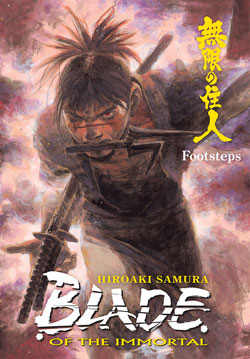
Manga Spotlight: Blade of the Immortal Volume 22: Footsteps by Hiraoki Samura Released by Dark Horse Manga
Various manga creators enjoy changing the situation and attitude of their work from time to time. Hirohiko Araki's Jojo's Bizarre Adventure has featured seven of the titular Jojo's: Victorian gentleman Jonathan Joestar; Jonathan's American, Jazz age martial artist/Indiana Jones grandson Joseph Joestar; Joseph's half Japanese teenage delinquent/super powered/horror puzzle solver grandson Jotaro Kujo; Joseph's local mystery solving teenage illegitimate son Josuke Higashikata; Italian gangster son of the Joestar family's enemy, Giorno Giovana; Jotaro's American, jailed daughter Jolyne Kujo; most recently, a horseback riding, alternate history version of Jonathan, Johnny Joestar. Though not uniformly the case, these phases get longer and longer as a popular manga persists. For example, the "El Baile de la muerte" phase of Black Lagoon was 75% the length of all the manga's chapters that preceded it. I've defended the "Prison Arc" stretch of Blade of the Immortal, in which the manga's prime swordsman was taken off the battlefield, chained in a hole in the ground and subjected to medical experiments. Depending on where you pin the start point, this chapter has been about a third of the length of the complete manga series from its inception to the end of the particular story line. Even with some admiration for the "Prison Arc," the idea of moving on is greeted with an exhalation. Now, Hiraoki Samura has moved Blade of the Immortal into its final phase, dubbed "Winter War." How long this will last is open to speculation, especially given that Hiraoki Samura has expressed interest in ending Blade of the Immortal for the majority of the last decade. "Footsteps" sets the chessboard and the time table for what does have the makings of a final conflict. Primary players renew their acquaintance with each other. Spoilers... maybe... Sori, the ninja master more interested in the world of art, including the banned Western variety, is back. Taito Magatsu, the anti-government punk swordsman puts in an appearance. Makie, the geisha who is probably the most gifted fighter in the series has something of a key role in the volume. Without violating the progress that the manga has made in developing its characters, many return to their pure, as-introduced presentation. Manji, the immortal of the title for example.... The character killed the corrupt lord who he had served. Then, he killed the many men sent to bring him to justice, earning him the moniker the "Killer of a Hundred." The last of these was his brother-in-law, an act of violence that shattered his sister's mind. Cursed with immortality, he swore to kill a thousand evil men to make amends for the hundred good ones. The thousand evil men for a hundred good ones equitation is a bit of reductive morality, and Blade of the Immortal has not so much ignored it as not respected it. The sister and the "Hundred Killer" haven't been evoked in a while, but both concepts make a return in Footsteps. Though Blade of the Immortal has returned to framing its protagonist with the parameters of his original concept, the tide of the manga has still turned Manji's mission into one of a number of cross currents. Undoubtedly, he still has a battle to face, but that's going to be a skirmish in the Winter War between the anti-establishment, Darwinian Itto-ryu sword school and the surrogates of Edo government power, specifically those under the command of banshu samurai Habaki Kagimura. There's an operating principle that seems to have shaped Blade of the Immortal for a while. Though he's been writing a popular genre work since 1994, Hiraoki Samura is not a genre devotee. As such, Samura needs to do what he can to stay interested in Blade of the Immortal. In the section in which Manji was imprisoned, this effort included experimenting with the subject of atrocities; specifically human experimentation and the actions taken to perpetuate a government in power. Samura continues to exercise that line of thought with the man who supervised those horrors, Kagimura. He's proving to be an involving character. His role in Blade of the Immortal is that of the villain that you really want to see taken down... hard. He's personally responsible for the deaths of hundreds. He's defeated, tortured, and frustrated the manga's heroes. Yet, he's neither an obvious black hat nor the kindof hard, ideal bound man who wins a sort of macho affection. Footsteps humanizes him. He has relationships. He has complex opinions about the actions he's undertook. This isn't the simple shonen fight tournament trick of adding history and dimensions to a foe at the eleventh hour, as they're being shown the door. If he's not buried from the records, Kagimura is the kind of guy that history either reviles or romanticizes. Samura works with ideas of what such a dangerous person would really be like as he develops the character's agenda going forward. This fleshing out of perspective is applied to other camps of the conflict during the volume's course, specifically the once antagonist, now large part of the series' focus, Itto-ryu. The manga has already worked a lot with these folks, but Footsteps more deeply develops how the Itto-ryu banner has been one that has both attracted and embraced revolutionary idealists like Magatsu, plainly evil men like misogynous serial killer Sabato Kuroi (Black Sabbath), criminals, madmen and the pathologically bellicose. Before becoming a target of higher powers, the Itto-ryu operated by challenging and obliterating the weaker sword schools that sprung up in the peace time of the Tokugawa shogunate. This volume offers the story of an Itto-ryu delegate named Boa Hoshi - a crude, drunken, pathologically angry monk who fit well into the Itto-ryu's retinue of outcasts. Though the Itto-ryu are being hunted down by the government, and the dojos smashed by likes of Boa have had the opportunity to spring back to their original form, a number of the formally trained former students of smahed dojos have tracked own the Ittu-ryu leadership to aid them in the conflict. It's an act akin to joining the suicidal Fight Club who kicked your ass as the FBI are breaking down their door. It says something about the Itto-ryu and the violent men it attracts. Beyond cementing ideologies and characters, Samura does what he's done regularly, but which might be a little odd for a manga supposedly entering its final phase. He introduces a host of new characters. There's the very political new face of the government, Hayabusa Ugen... a Janus with a weird mismatch of feminine and masculine features. There's the sure to impress new Itto-ryu field operative Baro Sukezane... a gift to the fans of the manga's sword fights. Two or three new ninja groups show up, offering something that this manga hasn't previously seen by way of hannya mask wearing cannon fodder. And, the true opportunity for Samura to stretch is skill at creating bands of exotic weapon carrying kenshi super groups... the "Six Demons" of Rokki Dan. There are great fight scenes to anticipate from these folks, especially as broadcast by a group shot of the Rokki Dan framed by a couple dozen masked ninjas. There's the grinning guy with the pencil moustache, the staff clutching moleman, the guy with the shaved head, nunchahu and tightly corded muscles, the one eyed man, with long hair, a skull cap and a weird miniaturized polearm, and the hulking dude with a scar splitting the middle of his cranium and, oddly enough, dreadlocks coming off the sides of his bald top. What sets the group apart from previous teams who are likewise schedule to meet on this upcoming battlefield, or have met with Manji or some other misfortune, is age. These aren't young turks. It's like what they say about kung fu movies... watch out for the old guy. He's presumably survived a lot and is capable of dealing out some hurting. Most of the Rokki Dan don't look AARP aged, but it does seem like these folks are veterans of some grave business. And the final member of the Rokki Dan who brings their number to six... well, she's a young swordswoman, and the daughter of someone. For a hint, her family crest, adorning the back of her battle gear also adorns the kimono of another character and the spine of Footsteps. Footsteps does feature some action, but it is a very crowded, very talky volume. Recently, I wrote about Shaman Warrior and how it didn't seem like Park Joong-Ki was bringing his best to that manhwa's ending. Samura has set the table, and if things proceed as laid out in Footsteps, fans of Blade of the Immortal, especially fans of its clash of exotic, intricately rendered fighters, should be very pleased. But, beyond putting together a clash of swords crowd pleaser, Blade of the Immortal's drive to persistence and popularity has been mediated by Hiraoki Samura's interests. And, whether it’s the literally torture porn Love of the Brute or the Burroughsian vision of Halcyon Lunch, the evidence from Samura's extra-BOI work is that his interests are strange and disturbing. Winter War might not be as unconventional as the prison piece, but Samura has by no means shed his interest in deviating from the genre norm. Oh yeah, Footsteps also includes the return of bonus features in the collected edition. It features one of the guides to Samura's outlandishly designed weapons. And, it features a large section of Blade of the Immortal's newly expanded female cast recast and redesigned as the population of a gal game (aka dating sim). This is extensively footnoted, and you could say "if you have to explain the joke...," but seeing the uncompromising women of Blade of the Immortal as school girls in a relationship story is amusing enough to almost be worth the price of admission in and of itself.
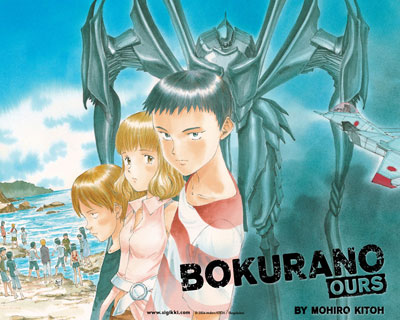
Manga Spotlight: Bokurano: Ours By Mohiro Kitoh Released by VIZ Media
Deb Aoki of about.com:manga recently collected hints for manga reviewers. Most were general suggestions for writing cogent reviews. Mine was more subject targeted. "You don't need to talk to it, but know the manga's context; specifically the anthology in which it was published." Manga may look like one thing, but be written for an entirely different audience. Kazuhiro Okamoto's Translucent for example. It's about a shy girl suffering from an affliction that causes her to turn invisible. It looks like a for girls shoujo story. It's been marketed as one. And yet, the manga was serialized in Comic Flapper, a seinen anthology for teenage males, and at times, it struggled with defining the female subject through the male point of view character. A work of manga might fit the readership you think would be interested in it, but the writing of that manga is going to be informed by the profile of its anthology's readership in Japan. And, if you go in thinking it’s for an audience other than that anthology's, sometimes the manga will violate your expectations. I'm not quite sure how it's possible, but publishers seem to have been caught up in this assumption trap. A prime example is Mohiro Kith’s Shadow Star aka Mauro Nauru Hoshi Tama Taro Kop ( The dead star and the jewel of a girl), abbreviated as Caruaru. It looks like a kid’s adventure story. Energetic/upbeat ("genii" character type) twelve year old Shine Tami finds a sort of merchandise-bait space star fish; a goofy, puppy dog eyed creature that can take the shape of a backpack or flatten out into a board onto which she can surf into the sky. Looks innocent. Looks fun. It hit America a bit after Pokémon and looked like a bit a mature more variant. It got slightly violent, then, it got very violent. Mohiro Kitoh has an instantly recognizable, distinctive way of stylizing his characters. There's a simplified abstraction. The bodies shapes are fairly realistic, but with the exception of emphasized contrasts, the forms have childlike litheness... as if no preteen/teens overeat or miss out on their exercise. This can convey youthful innocence, but it also conveys vulnerability. These are forms that are plainly susceptible to what cruelty might be thrown at them. People in Kith’s view of our world are quite capable of doing terrible things to each other. There's an idealized notion of people being happy and healthy. Circumstance can shatter that. So can maliciousness. Running in Afternoon, home of Blade of the Immortal, Blame!, Gunsmith Cats and Eden: It's an Endless World, Kitoh had the license to make such violations in Shadow Star truly gut wrenching. If you went into Shadow Star expecting a Poke'-adventure, the characters weren't the only ones due to be violated. Bokurano: Ours ran in alternative publication Ikki. More on this seinen periodical later, but for the time being, the important thing to know about Ikki is that it generally features manga with little visual resemblance to what most North American's think of as a manga look. Few entries have much name recognition here outside manga devotees. The best known is probably Sexy Voice and Robo, about a 14 year old girl with vocal talents who decides to turn them toward crime solving. Other company that Bokurano: Ours keeps includes A Serow's Deadly Fall - about grade schoolers and a goat/antelope; Taiyo Matsumoto's design crushing story of an assassin killing off other super powered world leaders - No. 5; story of forty something single father who decides and fails to become a hip manga creator - I'll Give It My All...Tomorrow; man with lizard head versus sorcerers - Dorohedoro. If you weren't familiar with Mohiro Kith’s history, if you were unaware of the character of its anthology, Kitoh still offers little opportunity to confuse Bokurano: Ours with a typical adventure. It opens with the statement "The year we started junior high we considered ourselves all grown up. We thought we could do anything. But in reality, we were just kids, sheltered by our parents and by society." On one hand, Bokurano: Ours puts lie to the notion that its subjects were entirely sheltered. On the other, Kitoh is getting at some of the themes of Mamoru Oshii's Sky Crawlers, from the opposite direction. In a statement about the movie Oshii said "in our peaceful country, there is no more starvation, revolution, or war. We have a society where we can live out our allotted spans of lives without ever having to feel deprived of food, clothing, or shelter...Isn't this comfortable life that we have achieved, a monotonous purgatory that doesn't end until we die?" Oshii accentuated that freedom from dire want in Sky Crawlers' consequence free game/war. Bokurano: Ours does the opposite by expositing children to exaggerated mortal peril. 15 children, eight seventh grade boys, six seventh grade girls, and one fourth grade girl visit a decaying sea side village as part of a school program. They think it's childish. They complain about the smell of the ocean and the "gross" shore creatures. There's a cave in the distance and the group decides to check it out for some diversion. There, they find an incongruous collection of computer equipment, framed by tarps and lights. A man in hiking gear turns up and explains that he's been developing a game, and that he's just about ready to recruit some play testers to "pilot a giant robot to defeat enemies! The planet Earth will be attacked 15 times! But a giant robot will rise to Earth's defense! A black colossus! Layer upon layer of armor! Unparalled strength! An indomitable goliath!" The man, later given the moniker Kokopelli, doesn't exactly win over the crowd with this speech, but he does manage to get them to put their hands to a contract. Later, the children are not sure if the experience with the man in the cave was reality or a shared dream; a question that is cleared up when they see fighter jet scrambled to intercept a tower dwarfing sort of black crustacean/man. A bizarre, sharp tooth teddy bear creature materializes in the air in front of the children, quickly clears up that he's "the almighty" and not some sidekick, then explains that their turn to pilot the giant robot is imminent. In a general sense, what they're involved with is standard fight the alien invader in your giant robot procedure. The enemy has a weak spot. Find it. Crack it. This was seen in Neon Genesis Evangelion, as well as plenty of works before and since. Kitoh impresses with the immense sense of scale and unique design of his giant weapons. The fights scenes are cataclysmic, but that's neither his forte nor the chief appeal of Bokurano: Ours. Some of the children embrace the opportunity to pilot a giant robot, seeing it as opportunity to become heroes or as a vehicle for fame. To others, it plays on their sense of obligation. Other still have no interest. Regardless of their enthusiasm or willingness, what becomes quickly apparent is that they've been roped into a sort of cosmic pyramid scheme. In that cruel trap, Kitoh is not so much deconstructing the giant robot story as using it as an industrial grade excavation devise to drill into human nature. Mohiro Kitoh has been accused of being misanthropic or hating children, and a case could be made for either assertion. An alternative view is that he's unafraid to lay his subjects bare. There's a banally cruel way in which he starts that process in Bokurano: Ours. The children are taken into the cockpit of their giant robot, which has been outfitted by chairs from their bedrooms. In that moment, the self conscious teens lose the ability to hide details about their lives from each other. Their economic situation and home lives are opened up. On has an executive chair... another has a floor cushion... "pretty ghetto man!" "what kind of life do you live anyways?" This is just the beginning. One by one, the children are forced into a temporary, godlike position. From that seat of life or death, earth shattering threat and responsibility each is forced to exhibit or develop a system for reconciling what happens. Whether they decide to be self sacrificing heroes or decide that the deaths of others are of no consequence to them, they relate the giant robot piloting experiences to their lives and crystallize a personal philosophy. Unlike the home chair outfitted in the cockpit for their peers to see, it's only the reader who becomes privy to these secrets. As the characters are developing reasons for it all, the next chapter, after the content of this volume underscores, or perhaps invalidates, this values exhibition with a dedicatedly nihilistic twist. From a Kitoh interview on Viz's Sigikki site "my original idea was about a girl with magical powers. Whenever she used her magic, it would steal life from those who were important to her. That became a story about a robot who risks its own life in order to save others." What's poignant or disturbing in this process is that Kith’s stories become engines that consume characters to forward exploration. Bokurano: Ours is a brutal manga, and Kitoh is able to channel the effect of that harshness. I've been critical of manga that I've considered tragedy porn, which use the edge of their painful consequences for little more than emotional scarification. Kitoh is giving every evidence of being more thoughtful than that. He's been developing each of his characters even in offhand moments. As a result, the tapestry of values being woven is taking shape into a provocative image. That said, Kitoh manga is divisive, and Bokurano: Ours is certainly no exception. Hiroyuki Morita, director of the Ghibli movie The Cat Returns, developed an anime adaption of Bokurano: Ours, but had a problem with Kith’s treatment of the characters. As such, Morita won the go ahead to rework some of the story's operating principles. In turn, Kitoh blogged to decry the break in vision and urged fans of the manga not to watch the anime. Reactions to Kitoh works, either positive or negative are liable to be deep seated. VIZ has experimented with supporting the localized releases of Ikki titles by serializing chapters online for free on Sigikki. For series like Daisuke Igarashi's Children of the Sea, Viz has rolled out the series ahead of its graphic novel release, removing material as it becomes available in the printed version. For the most part, this appears to be the case with Bokurano: Ours too. The trade paperback of volume one is scheduled to be released February 16, but chapters up to the first of volume two are still online. Preview chapters of published titles like Natsume Ono's Not Simple have also been made available on the site. The ends of posting some of the other works are less apparent. Eiji Miruno's Tokyo Flow Chart explains life by away of absurd process diagrams. It takes some work to develop an affinity for the manga, but only two chapters have been made available on Sigikki, in July and October '09. Tondabayashi's "What's the Answer" is an equally absurd work. There was one entry, posted in October, that responds to a kid on Christmas' question about "what was Santa doing yesterday." Based on the small sample size, it's difficult to work up an enthusiasm for the title. Sigikki has been widely praised by North American comic/manga industry commentators. However, the question is "what are Viz's plans for Sigikki." It was adding about three chapters of manga a week. This stopped on December 24th. On January 16th, a blog entry clarified that it was on a Holiday break. With the hiatus indefinate, its future is open to speculation. Gonzalo Ferreyra, Vice President of Sales and Marketing for Viz Media has commented on developing metrics for the effects of posting the manga online. The implication of this for the resumption of Sigikki, whether it involves tests like comparing sales of Children of the Sea while updating to Bokurano: Ours without, remains to be seen.
Upcoming in North America
Who knows how it reflect James Cameron's apparently dynamic agenda, but Yahoo Movies is saying that the Battle Angel Alita adaptation will be his next project.* A look at the new covers for the North American Ghibli re-releases* Features on the Astro Boy DVD release include * Two all-new animated sequences * Deleted scenes * Featurettes * Image gallery it's cover Bandai Bandai Visual Japan announced that Amazon.com will release the Mobile Suit Gundam UC(Unicorn) Vol.1 Blu-ray with a two-month exclusive window in North America under the “Honneamise” label. Amazon.com will be taking pre-orders starting on January 10 with a street date of March 12, 2010 at a SRP of $49.98. The story is set in Universal Century, three years after the events of the film Char’s Counterattack. The series will be comprised of six 50-minute episodes directed by Kazuhiro Furuhashi.The Blu-ray will feature Episode One with Japanese and English TrueHD 5.1 and Japanese and English Dolby Digital 2.0 audio with a 16:9 / 1080P High Definition transfer. Subtitle tracks will include Japanese, English, French, Spanish, and Chinese (in both Cantonese and Mandarin). The English voice cast features the talents of Steve Cannon, Stephanie Sheh, Rachael Lillis, Tara Platt, and others. Bandai Entertainment has scheduled Kannagi: Crazy Shrine Maidens Complete Collection ($59.98) and Lucky Star Complete Collection (Anime Legends, $49.98) for April 6th. Eureka Seven: Good Night, Sleep Tight, Young Lovers, Hayate the Combat Butler Part 4 and Kurokami The Animation Part 1 have been delayed to March 2nd. CMX POLYPHONICA: CARDINAL CRIMSON VOL. 1 Advance-solicited; on sale May 12 • 5” x 7.375” • 162 pg, B&W, $9.99 US • TEEN + Original story by Ichiro Sakaki and ocelot. Illustrated by Tomo Hirokawa CMX/Flex Comix. In a place called Polyphonica, humans and spirits live side by side. Young musicians create magical sounds with their music, which bind the spirits to them. A struggling student named Phoron accidentally summons a spirit he met in childhood but later forgot about. Phoron could use all the help he can get, but this feisty spirit may prove to be more than he can handle! STOLEN HEARTS VOL.2 Advance-solicited; on sale May 19 • 5” x 7.375” • 192 pg, B&W, $9.99 US • TEEN Written and illustrated by Miku Sakamoto MUSASHI #9 VOL.17 Advance-solicited; on sale May 5 • 5” x 7.375” • 200 pg, B&W $9.99 US • TEEN Written and illustrated by Miyuki Takahashi TERU TERU X SHONEN VOL.7 Advance-solicited; on sale May 19 • 5” x 7.375” • 192 pg, B&W, $9.99 US • TEEN + Written and illustrated by Shigeru Takao ORFINA VOL.8 Advance-solicited; on sale May 26 • 5.5” x 8” • 282 pg, B&W, $12.99 US • MATURE Written and illustrated by Kitsune Tennouji VENUS CAPRICCIO VOL.4 Advance-solicited; on sale May 5 • 5” x 7.375” • 192 pg, B&W, $9.99 US • TEEN Written and illustrated by Mai Nishikata Media Blasters Anime 4/6/2010 SUKISHO LiteBox - Volumes 1-3, Eps. 1-13 - 3 Discs - 325 minutes - $19.99 AH MY BUDDHA Complete Collection - Volumes 1-6, Eps. 1-26 - 650 minutes - $49.99 TEKKAMAN BLADE COLLECTION - Volumes 1-3, Eps. 1-49 - 9 Discs - 1250 minutes - $59.99 4/13 GENSHIKEN 2 Premium Box - Vols. 1-3, Eps. 1-12 - 3 Discs - 300 minutes - $59.99 BEAST KING GO LION COMPLETE - Volumes 1-3, Eps. 1-52 - 3 Discs - 1275 minutes - $69.99 4/20 DOJIN WORK COMPLETE - Volumes 1-3, Eps. 1-12 - 300 minutes - $49.99 BLUDGEONING ANGEL DOKURO-CHAN - Special Dubbed Edition - Eps. 1-18 - 2 Discs - 180 minutes - $29.99 IKKI TOUSEN DRAGON DESTINY - Sousou's Ambition - Volume 3, Eps. 9-12 4/27 KANOKON – THE GIRL WHO CRIED WOLF - Sexy Like a Fox - Volumes 1, Eps. 1-4 - 1 Discs MAGIC KNIGHT RAYEARTH - Season One Remastered - Volumes 1- 4, Eps. 1-20 - 4 Discs - 500 minutes - 39.99 (rescheduled AH MY BUDDHA Ikkou is your everyday teenage boy with everyday teenage desires. Too bad he's training to be a priest in a Buddhist temple full of incredibly gorgeous and obviously available priestesses. The temple is usually called on to perform exorcisms, and Ikkou's inner power is on hand for whenever things get out of control. A little flash of skin (usually a lot) from his female colleagues is enough to supercharge him, but the aftermath involves dealing with an extra turned-on priest whose loins were blazing to begin with. It's enough to make anyone cry out for Buddha to save them. BEAST KING GO LION COMPLETE From days of long ago... from uncharted regions of the universe... comes a legend... The legend of Golion, the original Japanese show that started it all in the world of Voltron. The five pilots may look the same, but their names and the events that occur are galaxies apart from the series you think you know. Were people evacuated safely? Do robots die? And what really happened to a certain main character? Revisit the Voltron series as you've never experienced it before, and see what really happened in this newly restored and uncut version. BLUDGEONING ANGEL DOKURO-CHAN Imagine a world where the secret to immortality has been discovered, causing women to stop aging by the time they turn twelve. Sounds like it might be a perfect playground for a discoverer with less-than-wholesome interests, doesn't it? That's exactly why the Big Man Upstairs sends Dokuro-chan, one of his angelic assassins, into the past to "deal" with the sicko who messed with nature. But Dokuro-chan decides instead to move in with her target, Sakura Kusakabe, and keep him too occupied to find eternal life. Funnily enough, the path of nonviolence leads to a fountain of blood, as Dokuro-chan accidentally kills Sakura on an almost daily basis, only to resurrect him with a magical chant moments later. DOJIN WORK COMPLETE Dojin Work follows the life of a young girl named Najimi Osana and her exposure into the doujin world. She was first tempted into becoming a dojin artist after seeing how much one of her friends can make at a convention. Najimi loves to draw, though soon learns, contrary to what she expected, that this new world is anything but easy. As she attends more conventions and meets more people, Najimi eventually manages to find a group of very interesting friends. These friends already have some experience in the field and help her out along the way so that she can someday make a name for herself creating dojinshi. GENSHIKEN 2 The Society for the Study of Modern Visual Culture, otherwise known as Genshiken, is now under the charge of a more confident Sasahara. Things have changed in between semesters (for all the details, check out the bonus Genshiken OVAs included on the Kujibiki Unbalance TV series), and the otaku club now has a new otaku-hating member named Ogiue. Sasahara's initial goal of starting a dojin circle and selling those fan-made magazines at the next Comic Festival becomes a reality, but reality is a cruel master. Who apparently Cosplays. Afterward, the club is abuzz with talk about Tanaka and Ohno's relationship, which takes a hesitant step forward. KANOKON – THE GIRL WHO CRIED WOLF Kouta, a country boy who lives with his grandfather, is now moving to the city to attend high school. Changes come with his new home and new school, but nothing could have prepared the gentle young man for girls, specifically a bombshell fox spirit named Chizuru. As if her aggressive advances weren't enough, he also catches the attention of a frosty wolf spirit named Nozomu. Kouta is dragged into supernatural events as a result of his contact with the two girls, and his school life only gets more chaotic by the day. But with a girl who gives "foxy" new meaning and another howling after him, things are looking up for his love life. SUKISHO Sora fell from the roof of his high school and was knocked unconscious. When he finally awoke, he found a kind-hearted boy named Sunao waiting over him. Sunao claims to be his best friend, but the fall erased some of Sora's memory. He doesn't remember Sunao at all, the wide-eyed young man acts like much more than just a friend. From that day on, Sora begins to experience flashbacks in which he is not himself, but a mysterious alternate personality with hidden powers. He begins to search for the secret of his lost memory and the flashbacks, but will Sunao be his companion, or his enemy? TEKKAMAN BLADE COLLECTION It is the near future, United Space Calendar Year 192. The evil alien Radam has besieged the Earth, gaining control of the enormous Orbital Ring that surrounds the planet, and raining down mysterious spores that fill Earth with alien plants. Aki and Noal, two pilots from the Outer Space Development Group, find one of the alien lieutenants who crash-landed on Earth. The stranger claims to have no memory, and is determined to fight to protect humanity! His name is D-Boy, and he appears to be a normal human, until he transforms into the bio-mechanical warrior, Tekkaman Blade! Manga 4/14/2010 AKIHABARA@DEEP - Volume 6 of 6 Live Action 4/13/2010 Hansel And Gretel 4/27 KID WITH THE GOLDEN ARM DEADLY DUO (Blu-ray) Section23 April slate of DVD releases, include the first set of Japan’s long-running anime series Gintama. Sentai will also issue three other anime series sets in April, including Hidamari Sketch x 365, Living for the Day After Tomorrow, and Le Portrait de Petite Cossette. Switchblade Pictures has two live-action DVD releases from Japan, including Space Ranger Complete Collection and Venus Ranger. Product details follow, in order of release HIDAMARI SKETCH X 365 COMPLETE COLLECTION Published by: Sentai Filmworks Distributed by: Section23 Films Run Time: 400 min. Street Date: 4/6/2010 Format: DVD SRP: $39.98 SYNOPSIS: You didn't think Yuno's story was over, did you? Of course it isn't, but if you've seen the first series of Hidamari Sketch, you should know not to expect the "A happens after B after C" pattern of the rest of the world. In fact, instead of just taking place after Yuno's first year at Yamabuki High, X365 continues the saga on both sides, around and in-between, filling in the details in an ever-expanding collage that's both avant-garde and slice of life! And if the format's not completely unexpected, we guarantee that some of the things that you never knew about before WILL be! LE PORTRAIT DE PETITE COSSETTE Published by: Sentai Filmworks Distributed by: Section23 Films Run Time: 120 min. Street Date: 4/20/2010 Format: DVD SRP: $19.98 SYNOPSIS: What happens when the face you see in a reflection isn’t your own? That’s the shock that awaits Eiri Kurahashi when he sees the living image of Cossette d'Auvergne in a glass in his uncle’s antique shop. Infatuated, he becomes possessed and mysteriously makes contact with the beautiful young aristocrat, only to learn that she was murdered 250 years earlier. Now, her soul trapped inside the goblet, she can only be set free if someone is willing to pay for the sins of her murderer, the artist Marcelo… who may very well have been reincarnated as Eiri! As shadowy forces surround Eiri, his love for Cossette drives him down a tortuous path of self-destruction, while those who love him in the real world can only watch in horror! GINTAMA COLLECTION 1 Published by: Sentai Filmworks Distributed by: Section23 Films Run Time: 325 min. Street Date: 4/27/2010 Format: DVD SRP: $39.98 SYNOPSIS: Life isn’t easy in feudal Japan… especially since the aliens landed and conquered everything! Oh sure, the new health care is great, but the public ban on the use of swords has left a lot of defeated samurai with a difficult career choice! This is especially true if they’re not particularly inclined towards holding a day job, which is why Gintoki Sakata’s opted for the freelance route, taking any job that’s offered to him as long as the money’s right. Unfortunately, in a brave new world filled with stray bug-eyed montsters, upwardly mobile Yakuza and overly ambitious E.T. entrepreneurs, those jobs usually don’t pay as well as they should for the pain, suffering and indignities endured! LIVING FOR THE DAY AFTER TOMORROW COMPLETE COLLECTION Published by: Sentai Filmworks Distributed by: Section23 Films Run Time: 300 min. Street Date: 4/13/2010 Format: DVD SRP: $39.98 SYNOPSIS: There are far worse things than having to deal with your ex-boyfriend’s little sister or your older brother’s ex-girlfriend. But that’s something Karada Iokawa and Shoko Nogami have to learn the hard way when a magic wishing stone inexplicably grants Karada’s wish to be older. And does it by stealing the years from Shoko! Now Shoko, who’s already graduated and studied overseas, is Karada’s age, just about to enter junior high school. Meanwhile Karada must suddenly face the real facts about what being grown up entails. And just to make a bizarre situation even more awkward, there’s the issue of how to handle their existing romantic interests! SPACE RANGER COMPLETE COLLECTION Published by: Switchblade Pictures Distributed by: Section23 Films Run Time: 120 min. Street Date: 4/13/2010 Format: DVD SRP: $19.98 SYNOPSIS: With the power of the Treasure Sword at his command, the King of Valhalla has maintained peace and prosperity across the universe. But when the sword goes missing it's up to three magnificent female warriors - Sting Blue, Orna Black and Caliban Red - to set forth on a mission and recover it before the forces of darkness can steal it for their own! Unfortunately, while the warriors are magnificent, they really don't get along well and foolishly divide their forces, even as the nefarious Dron Brothers of the Dark Planet close in on the sword itself! Now, in a horribly backwards part of the galaxy, on an insignificant world known as Earth, the fate of all creation will be determined in a knock down, hand to hand battle to the finish! VENUS RANGER Published by: Switchblade Pictures Distributed by: Section23 Films Run Time: 95 min. Street Date: 3/30/2010 Format: DVD SRP: $19.98 SYNOPSIS: When four beautiful girls sneak into the hideout of a shadowing organization, they suddenly find themselves being drafted as holy warriors in the ancient war of good versus evil! On the side of darkness is the Golden Venus, on the side of light, the Mysterious Silver! Scheming beastly goddesses, massive girl on girl battles and an epic spin on the entire powered ranger genre propel the V-Forces through an epic tribute to classic Japanese live action entertainment! No punches are pulled! All breasts are mostly real! Recent Section23 releases include Hidamari Sketch and Glass Mask HIDAMARI SKETCH SEASON 1 COLLECTION Running Time: 350 min. Age Rating: TV PG Language: Japanese with English Subtitles Published by: Sentai Filmworks Distributed by: Section23 Films Format: DVD SRP: $39.98 SYNOPSIS: For years, Yunos dreamed of attending Yamabuki Arts High School; but now that she’s been accepted, it means the scary prospect of moving away from her home and family for the first time! Fortunately, Yuno quickly learns that if her new neighbors at the eclectic Hidamari (Sunshine) Apartments aren’t technically family, at least the majority share the bond of being fellow art students. From second year students like Hiro and Sae, who try to behave like helpful older sisters (mostly successfully) to her hyperactive new neighbor, classmate and best friend Miyako (who has the scariest apartment ever,) Yuno begins to build the support network she’ll need for dealing with strange characters like her oddly masculine Landlady, her cosplay obsessed home room teacher, her tooth-chattering Principal and all of the other odd denizens who inhabit her chosen world of art. It won’t be easy, and it won’t always be pretty, but with her friends at her back, Yuno’s going to reach for the stars in HIDAMARI SKETCH! GLASS MASK COLLECTION 1 Running Time: 650 min. Age Rating: TV PG Language: Japanese with English Subtitles Published by: Sentai Filmworks Distributed by: Section23 Films Format: DVD SRP: $49.98 SYNOPSIS: Two Girls. One Dream. And the Entire World for a Stage. At 13 years old, Maya Kitajima seems destined to spend the rest of her life toiling in a crowded restaurant alongside her bitter and unstable mother; but when her incredible acting talent is discovered by the legendary diva Chigusa Tsukikage, Maya finds a new future filled with both golden opportunities and terrifying risks. For Ayumi Himekawa, success has always been assured, yet she longs to be recognized for her own talents and skills, not the family connections of her famous parents. For both, the ultimate prize is the role of The Crimson Goddess in the play of the same name, a part created by Chigusa and now portrayed by Ayumi’s mother. To achieve this goal, each must seek out and conquer every acting challenge, pushing the limits of their talent and endurance to the utmost, until they are worthy of the part…. But for one to win, the other must fail! The dramatic rivalry of a lifetime begins in the acclaimed first collection of GLASS MASK! SPECIAL A COLLECTION 2 Running Time: 300 min. Age Rating: TV PG Language: Japanese with English Subtitles Published by: Sentai Filmworks Distributed by: Section23 Films Format: DVD SRP: $19.98 Special A Collection 2 assembles the last 12 episodes of the hit TV series, also known as “S.A.,” in a single two-DVD set. The series was first broadcast in Japan in April 2008 and has been widely anticipated by North American fans ever since. SYNOPSIS: The members of the S.A. may be exceptional, but that doesn’t keep some of them from being exceptionally dense! While Kei’s thoughts about Hikari may be leaning in one direction, Hikari still sees him as the obstacle that has to be removed. Meanwhile, Akira’s attempts to protect her friend Yui from Yahiro are having unanticipated effects, Jun is forced to reveal a secret he’s been keeping from the others, and every other person in the group seems to be in love with someone else, but never the right ones. Finally, to cap it all off, an outside force threatens to intervene in a way that will destroy the S.A. forever! Will Hikari finally figure it all out before it’s too late? If you thought the tangled web of relationships in the first half of Special A was complex, be forewarned that everything’s going to get even crazier before the spectacular climax of SPECIAL A – COLLECTION 2! Vertical Kuriousity notes that Amazon is listing an October 19th release for Osamu Tezuka's 1972 work Ayako. Serialized in seinen anthology Big Comic, the story comments on the effect of American's occupation of Japan. Publishers Weekly adds will also rerelease Tezuka’s MW, this time in a paperback edition, alongside Ode to Kirihito which Vertical is splitting into two volumes. VIZ Media BIOMEGA • by Tsutomu Nihei • Available February 2nd • Rated ‘M’ for Mature Audiences • VIZ Signature Imprint Zoichi Kanoe plunges into the depths of 9JO, a sprawling island city in the middle of the Pacific Ocean, in search of Eon Green, a girl with the power to transmute the N5S virus. The deadly contagion is spreading across the world and turns humans into disfigured zombie-like "drones.” But he's not the only one looking for her. Agents of the Public Health Service's Compulsory Execution Unit are also in hot pursuit with sinister designs of their own. Zoichi and his trans-human allies have no time to waste; the countdown to the apocalypse has begun! BOKURANO: OURS• by Mohiro Kitoh • Available February 16th • Rated ‘T+’ for Older Teens • VIZ Signature Imprint One summer, fifteen kids innocently wander into a nearby seaside cave. There they meet a strange man who invites them to play an exciting new video game. This game, he explains, pit


